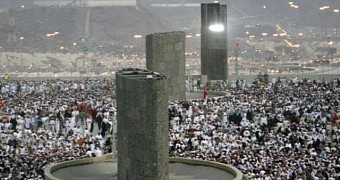This week, Muslims observed one of the biggest holidays of the year, the Eid al-Adha, also known as the Feast of Sacrifice. The Hajj pilgrimage to Mecca, which marks the end of the Eid al-Adha, turned the holiday into the biggest tragedy of the Hajj in 25 years, as a stampede killed over 700 pilgrims.
Hundreds more were injured. Saudi Arabia had invested billions of dollars into the area that houses some 1.5 million people on its busiest days, but even recent security and crowd control measures have proved ineffective, CNN reports.
Estimates say that anywhere between 2 to 3 million people had taken part in this year’s pilgrimage. A state investigation is currently underway.
The Eid al-Adha and the Mecca pilgrimage
The Feast of Sacrifice lasts 4 days and honors Abraham, who was asked by God to sacrifice his own son as a sign of his obedience and faith. The Devil tried to dissuade him from obeying, but Abraham held strong, determined to do as he was told.
When the moment of sacrifice came, God gave Abraham a sheep to slaughter instead. Muslims observe this holiday by sacrificing animals, which are usually divided into 3 parts, 2 of which are given to the poor and to family and neighbors.
The Hajj pilgrimage at Mecca must be taken at least once in the lifetime of any Muslim in good health. It spans more than one day and includes the “stoning of the Devil,” a ceremony that sees pilgrims cast pebbles at 3 stone walls that represent the Devil’s temptations.
During this part of the ritual, the latest stampede occurred: the Telegraph notes that it’s the deadliest incident to mark this holy day since 1990, when 1,426 people lost their lives in similar circumstances.
The Mecca stampede of 2015
Despite the fact that Saudi authorities had employed a British firm to design a crowd analytics software to help with crowd control, the area where the stampede occurred was not covered by it. Two large crowds of pilgrims arrived at the same time at a junction of streets known for being a bottleneck, and chaos erupted.
Footage and photos from the scene, which started popping up online within minutes of the stampede, showed police and paramedics overwhelmed by a tragedy no one anticipated: bodies were lying lifeless, piled on the ground, as those who had survived were desperately turning them over, looking for any signs of life.
The Telegraph points out that the number of deaths is well over 710, while more than 860 others suffered serious injuries. An investigation is now underway to determine the cause of the rush in pilgrim traffic and whether the authorities can be held accountable for not doing more to prevent it.
The Saudi Health Minister is laying the blame for the stampede on “unruly” pilgrims, but crowd control experts from the UK tell the publication that the pilgrimage has a history of such tragedies, which means that stricter measures than those taken already are in order.
“In general, the reason why there are crowd crushes are because there are problems with management,” John Drury, an expert in crowd psychology at the University of Sussex, says. “People can't see how dense a crowd is when they are in one, they have what we call poor ‘back to front communication.’ So when it goes wrong you cannot blame the crowd because they are not in a position to be blamed.”
This was in response to the Saudi Minister’s claim that the tragedy wouldn’t have happened if the pilgrims had “followed instructions.”
لا تزال عمليات الفرز مستمرة، وارتفع عدد الإصابات إلى 400 إصابة و 150 حالة وفاة. pic.twitter.com/HjZ2QuiYst
— الدفاع المدني (@KSA_998) September 24, 2015

 14 DAY TRIAL //
14 DAY TRIAL //